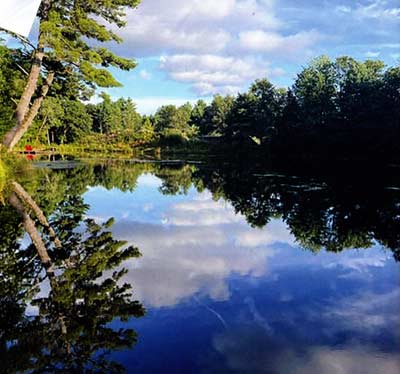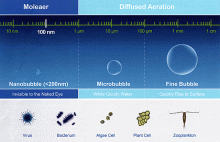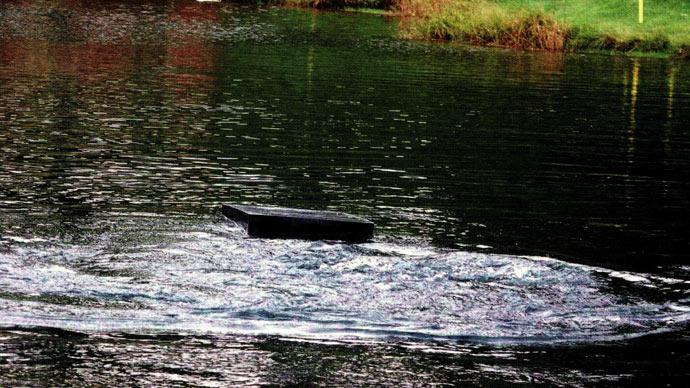
In the late 1990s and into the early 2000s, aeration was the new rage in lake and pond management. By the mid-2000s, companies were competing heavily in this new market.
Aeration has made a giant impact on our ponds...and our industry.
Building a bridge from the wastewater management business, bottom-diffused aeration was the main focus of several companies. Look at some of those in your Pond Boss Resource Guide.
Bottom-diffused aeration is basically a high-volume, low-pressure compressor pushing air through a hose to a proprietary (depending on which company) diffuser. The diffuser breaks the air into tiny bubbles that cascade through the water column, creating a fast-moving plume that pushes bottom water toward the surface, where the bubbles burst, like Alka-Seltzer, back in the day. There, bottom water pushed upward interacts with the atmosphere, exchanges gases, and does the biological magic it's designed for.
Other machines have entered the pond management scene to assist in the primary focus of the process—moving water. Circulators, fountains, solar-powered water movers, pumps, and many creative gadgets hit the market with that focus.
The next iteration is working out its kinks and figuring out its role.
Nanobubbles.
Research and development are ongoing. Like its older aeration distant cousins, Nanobubble technology is crossing over from agricultural, industrial, and wastewater management uses. The technology captures atmospheric air, compresses gases, pushes them through a tiny diffuser, and injects those gases into the water. Atmospheric air is about 20% oxygen. Going through a nanobubble machine, oxygen is enriched to about 40% and converted into bubbles too small to see, about 0.2 microns.
After a recent conversation with nanobubble technology leader Moleaer representatives, this technology is becoming clearer regarding its use in pond management.
Here's the fundamental concept. Neutrally buoyant oxygen nanobubbles stay within the water column with the goal of injecting them into the column of water below the thermocline until they dissolve into the water or oxidize with something.
One of the observations Moleaer has found with their units is much of the oxygen injected into the lower part of the water column tends to be quickly consumed by microscopic organisms demanding it at the water-pond bottom interface.
Oxygen nanobubbles have a negative charge, meaning they don't collect to make bigger bubbles. That means more time to dissolve—unless they are quickly used... which is happening often, oxidizing organic stuff on the pond bottom.
One of Moleaer's goals has been to inject enough oxygen into the water to support fish life in lakes' naturally anoxic deeper waters.
It doesn't appear to be there quite yet. However, some good things are happening with Moleaer's research. They are seeing their units working to mitigate circumstances of excess algae growth, especially in smaller waters. Moleaer's Todd Olson explained, "Most people don't understand what's on the bottom of their ponds. A restorative device like ours takes some time to break down organic matter." He said, "We are learning what our equipment can do and then make sure people understand the concept of the right tool, at the right place, and at the right time."
Moleaer equipment not only injects oxygen nanobubbles into the water, but its gentle pumping force also moves the water.
Over the past couple of years, Moleaer has partnered with several companies to put the equipment to work in practical environments. One case study was a private golf club community in Vero Beach, Florida, just off the Atlantic Ocean.
There are several water hazards on the property, including a flyover to the fairway on the 18th hole. Frequent algae blooms covered the surface. Poor water quality and odors didn't fare well in the eyes or noses of the golfers.
Moleaer worked with a local lake management company that assists the golf course. They installed two Moleaer units in August 2022. Oxygenating the small water body and oxidizing organic material in the water column and pond bottom helped nature digest the muck and change the biology of this important water hazard. During the first five months of operation, the golf course tolerated two hurricanes and a third major rainfall event. Algae was a battle for those in charge of the pond for four more months.
Nanobubbles were quietly doing their work.
By late December, algae blooms had been greatly reduced, and the water hazard had just cleared up. Golfers could again see the sandy bottom of the pond, and foul odors were gone.
All parties credit nanobubbles.
A Wisconsin trout pond benefitted from Moleaer's technology and consulting. Mid-summer, this pond, near Tomah, would be loaded with aquatic plants, especially coontail. The risk of treating with herbicides wasn't worth the effort. Traditional bottom-diffused aeration would stir up the highly eutrophic pond, quickly resulting in fish kills. Nanobubble technology came to the rescue for this pristine brook trout habitat. The oxidative effect of nanobubbles broke down the nutrient load and improved the health of the pond—chemical free.
Graphic comparison of bubble sizes.
Several other case study projects are seeing similar results. The bottom organic matter is reducing, and the consequences are apparent. Water is becoming happier, algae is being reduced, and a pond notorious for its fish kills hasn't had one since installing these units. Another pond, infamous for midge flies, has seen a dramatic reduction of those pesky insects...all because nanobubbles are expediting nature's way of composting organic stuff on the bottom of the lakes and ponds. Take away midge food and its prime habitat; they go away—or at least reduce their amounts measurably.
The sticker price for these units is still pretty high but is becoming more reasonable. As the industry determines the best way to use this technology, its value will become much more evident.
Nanobubble technology is working its way into the pond management industry, and word-through-the-grapevine suggests that even more dramatic results will be forthcoming.
Happy water means happy ponds and lakes!
Reprinted with permission from Pond Boss Magazine




